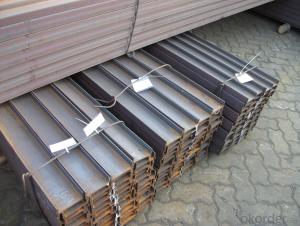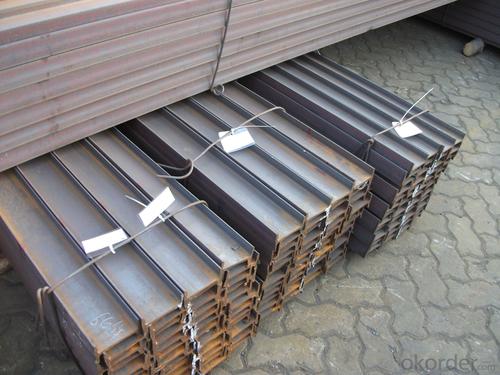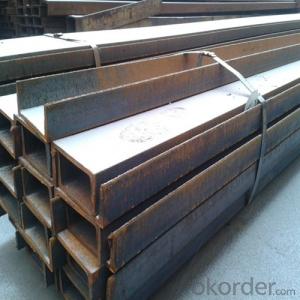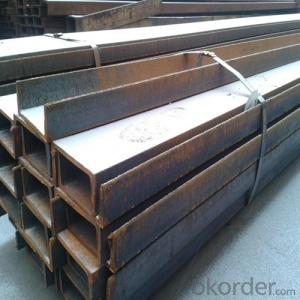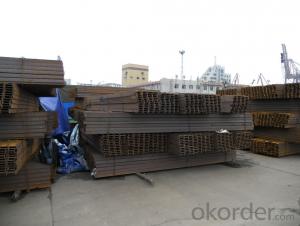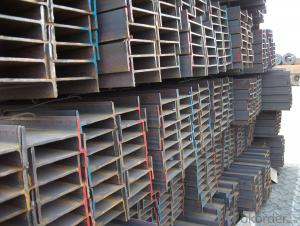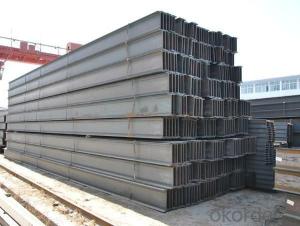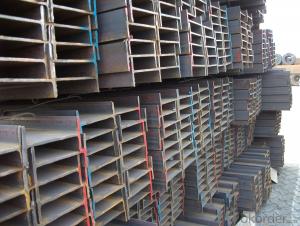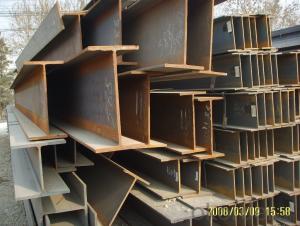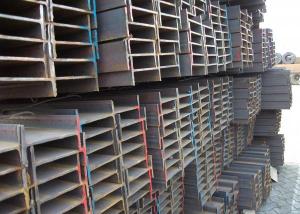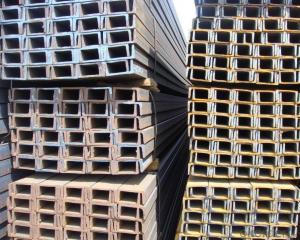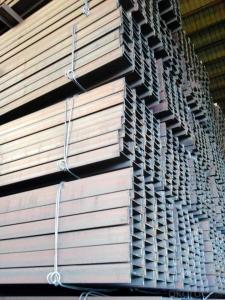IPE/ IPEAA steel beam
- Loading Port:
- Tianjin
- Payment Terms:
- TT OR LC
- Min Order Qty:
- 2000 m.t.
- Supply Capability:
- 20000 m.t./month
OKorder Service Pledge
OKorder Financial Service
You Might Also Like
Product Description:
Specifications of I BEAM European standard of IPE and IPEAA
size | Kg/m |
IPE 100*55*4.1 | 8.1 |
IPEAA 100*55*3.6 | 6.72 |
IPE 120*64*4.4 | 10.4 |
IPEAA 120*64*3.8 | 8.36 |
IPE 140*73*4.7 | 12.9 |
IPEAA 140*73*3.8 | 10.05 |
IPE 160*82*5.0 | 15.8 |
IPEAA 160*82*4 | 12.31 |
IPE 200*100*5.6 | 22.4 |
IPEAA 200*100*4.5 | 17.95 |
Grade: Q235B, Q235, Q345B, SS400, A36 etc
Standard: EN standard etc
Length: 6m, 12m, or as the customers’ requirements.
Usage of I BEAM European standard of IPE and IPEAA :
1.Support structures 2.Pre-engineered buildings 3.Prefabricated structure
4.It is widely used in various building structures and engineering structures such as roof beams, bridges, transmission towers, hoisting machinery and transport machinery, ships, industrial furnaces, reaction tower, container frame and warehouse etc.
Payment terms: TT or LC.
Package: packed in bundles and then shipped by break bulk or containers.
- Q: How do steel I-beams resist deflection?
- Steel I-beams resist deflection due to their structural design and material properties. The shape of an I-beam, with its flanges and web, distributes the load evenly along its length, allowing it to carry heavy loads without significant bending or sagging. Additionally, steel as a material has high strength and stiffness, making it resistant to deformation and reducing deflection.
- Q: What are the considerations for blast resistance of steel I-beams?
- To ensure the blast resistance of steel I-beams, it is important to take several factors into account. 1. Material selection is crucial in determining the blast resistance of the I-beams. High-strength steels like Grade 50 or Grade 60 are commonly used for blast-resistant structures due to their ability to effectively absorb and dissipate energy. These steels possess superior mechanical properties and can withstand the high pressures and shockwaves generated by explosions. 2. The design and geometry of the I-beams significantly influence their blast resistance. Proper sizing, spacing, and arrangement of the beams can enhance their ability to resist blast loads. Additionally, reinforcing sections or adding extra bracing can improve overall structural integrity and resistance to blast forces. 3. Connection details between the I-beams and other structural elements are critical considerations for blast resistance. Ensuring that these connections are properly designed and sufficiently reinforced can prevent premature failures and maintain the overall structural integrity of the system. 4. Understanding blast loading parameters, such as peak pressure, impulse, and duration, is essential for designing blast-resistant steel I-beams. The beams must be capable of withstanding sudden pressure increases and resulting shockwaves without significant deformation or failure. These blast loading parameters are typically determined by the proximity of the structure to the explosion source and the type of explosive used. 5. Dynamic response analysis is crucial for assessing the blast resistance of steel I-beams. This analysis involves evaluating the structural response to blast loads, including blast-induced vibrations, displacements, and strains. By simulating actual blast events, engineers can identify potential weaknesses and optimize the design to improve blast resistance. 6. Testing and validation are vital steps to ensure the blast resistance of steel I-beams. Full-scale blast tests or scaled-down simulations can be conducted to validate the design and assess the performance of the I-beams under blast loads. These tests help verify structural integrity, confirm the effectiveness of design measures, and provide confidence in the blast resistance of the I-beams. In conclusion, considering material selection, design and geometry, connection details, blast loading parameters, conducting dynamic response analysis, and performing testing and validation are crucial when designing steel I-beams for blast resistance. Addressing these factors allows engineers to develop robust and reliable structures capable of withstanding the destructive forces of explosions.
- Q: How do steel I-beams perform in terms of energy efficiency?
- Steel I-beams are known for their strength and durability, but when it comes to energy efficiency, they may not be the most ideal choice. Steel is a good conductor of heat, which means that it can easily transfer heat from the inside to the outside of a building or vice versa. This can result in significant energy loss when it comes to heating or cooling a space. Additionally, steel production is energy-intensive, requiring large amounts of energy to extract and refine iron ore and coal to produce steel. This process contributes to greenhouse gas emissions and is not considered environmentally friendly. However, it is important to note that energy efficiency is not solely determined by the choice of I-beams, but rather the overall design and construction of a building. Proper insulation, efficient HVAC systems, and energy-efficient windows can help mitigate the impact of steel I-beams on energy efficiency. Furthermore, steel I-beams offer advantages in terms of structural integrity and design flexibility, allowing for larger open spaces and longer spans. These benefits can lead to more efficient use of materials and potentially reduced construction costs. In conclusion, while steel I-beams may not be the most energy-efficient choice, their overall impact on a building's energy efficiency can be mitigated through other design and construction measures. It is important to consider the entire building envelope and energy systems when evaluating the energy efficiency of a structure.
- Q: How can I distinguish I-beam from H?
- H steel is widely used in steel structure construction. It has many differences comparing with i-beam.1) the flange, the inner edge of the flange has no inclination, parallel to the upper and lower surfaces.2) the outer two sides of H steel are not inclined, and they are straight.3) the section characteristics of H steel are obviously superior to those of traditional I-beam, channel steel and angle steel.
- Q: Can steel I-beams be used in aviation or aerospace renovation projects?
- Yes, steel I-beams can be used in aviation or aerospace renovation projects. They are commonly used in aircraft hangars, aerospace manufacturing facilities, and other aerospace structures due to their high strength and load-bearing capabilities. Steel I-beams provide structural support and stability, making them suitable for various applications in aviation and aerospace projects.
- Q: Can steel I-beams be used for pharmaceutical facilities?
- Yes, steel I-beams can be used for pharmaceutical facilities. They are commonly used in construction due to their strength and structural integrity, making them suitable for supporting heavy loads and ensuring the stability of the facility. Additionally, steel I-beams are resistant to fire, corrosion, and pests, which are important considerations in pharmaceutical facilities where safety and hygiene are paramount.
- Q: Can steel I-beams be used for sports stadiums or arenas?
- Yes, steel I-beams can definitely be used for sports stadiums or arenas. Steel I-beams are commonly used in the construction of large structures like stadiums due to their high strength and load-bearing capabilities. They provide the necessary support and stability required to handle the weight of the structure, seating areas, and other components. Additionally, steel I-beams offer flexibility in the design and construction process, allowing for the creation of unique and innovative stadium structures.
- Q: Can steel I-beams be used in coastal areas with high humidity?
- Yes, steel I-beams can be used in coastal areas with high humidity. However, it is important to consider the potential impact of the corrosive effects of saltwater and high humidity on the steel beams. In such coastal environments, the steel beams should be properly coated or protected to prevent corrosion. This can be achieved through the use of corrosion-resistant coatings, such as galvanization or epoxy paint. Regular inspections and maintenance should also be carried out to identify and address any signs of corrosion, as well as to ensure the structural integrity of the steel beams. By taking these precautions, steel I-beams can be effectively used in coastal areas with high humidity.
- Q: Are steel I-beams prone to corrosion?
- Indeed, corrosion is a common issue with steel I-beams. Typically crafted from carbon steel, these I-beams are vulnerable to corrosion when exposed to moisture and oxygen. When the iron in the steel interacts with oxygen, it forms iron oxide, commonly referred to as rust. This rusting process weakens the I-beam's structural integrity and can result in significant damage if not addressed. To reduce the risk of corrosion, protective finishes like paint or galvanization are often applied to steel I-beams. These coatings create a barrier between the steel and the surrounding environment, preventing direct contact between the metal and moisture or oxygen. It is also vital to regularly inspect and maintain the I-beams to promptly identify any signs of corrosion and implement appropriate measures to prevent further harm. Despite these preventive measures, steel I-beams can still be susceptible to corrosion, particularly in harsh environments such as coastal areas with high salt levels in the air. Therefore, it is crucial to consider the environmental conditions when selecting the type of steel and protective coating for I-beams. This consideration will help minimize the risk of corrosion, ensuring the longevity and structural integrity of the I-beams.
- Q: How do steel I-beams contribute to sustainable design practices?
- Steel I-beams make significant contributions to sustainable design practices in several ways. Firstly, steel possesses excellent recyclability. When a building reaches the end of its life cycle, steel I-beams can be effortlessly disassembled and recycled, reducing the necessity for new steel manufacturing and minimizing waste. This helps preserve natural resources and diminishes the environmental impact associated with steel production. Secondly, steel I-beams offer an exceptional strength-to-weight ratio, enabling the creation of efficient structural designs. This means that less steel is needed to support a given load, resulting in lighter and more cost-effective structures. The decreased weight also leads to lower energy requirements for transportation and installation, thus minimizing carbon emissions connected to these processes. Furthermore, steel is renowned for its durability and longevity. Steel I-beams boast a lengthy lifespan and require minimal maintenance compared to other building materials. This reduces the need for frequent repairs or replacements, conserving resources and reducing waste over time. Additionally, steel exhibits resistance to fire, termites, and other pests, eliminating the necessity for chemical treatments and enhancing the overall safety and health of the building. This aligns with sustainable design practices that prioritize occupant well-being and minimize the use of harmful substances. Lastly, steel I-beams can be designed with adaptability in mind, allowing for future modifications or expansions. This flexibility reduces the need for demolition and reconstruction, thus saving both resources and costs. In conclusion, the integration of steel I-beams into sustainable design practices contributes to resource conservation, decreased carbon emissions, improved occupant safety, and long-term cost savings.
Send your message to us
IPE/ IPEAA steel beam
- Loading Port:
- Tianjin
- Payment Terms:
- TT OR LC
- Min Order Qty:
- 2000 m.t.
- Supply Capability:
- 20000 m.t./month
OKorder Service Pledge
OKorder Financial Service
Similar products
Hot products
Hot Searches
Related keywords
